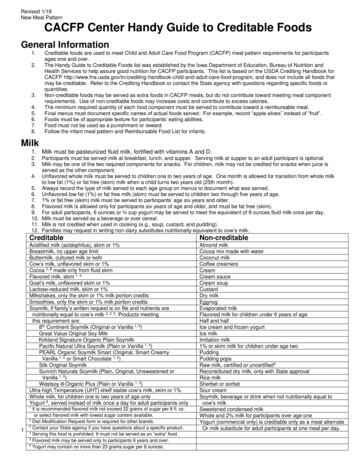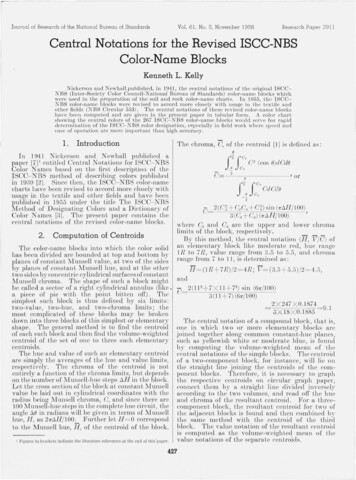
Transcription
Revised 1/18New Meal PatternCACFP Center Handy Guide to Creditable FoodsGeneral Information1.2.3.4.5.6.7.8.Creditable foods are used to meet Child and Adult Care Food Program (CACFP) meal pattern requirements for participantsages one and over.The Handy Guide to Creditable Foods list was established by the Iowa Department of Education, Bureau of Nutrition andHealth Services to help assure good nutrition for CACFP participants. This list is based on the USDA Crediting Handbook forCACFP d-and-adult-care-food-program, and does not include all foods thatmay be creditable. Refer to the Crediting Handbook or contact the State agency with questions regarding specific foods orquantities.Non-creditable foods may be served as extra foods in CACFP meals, but do not contribute toward meeting meal componentrequirements. Use of non-creditable foods may increase costs and contribute to excess calories.The minimum required quantity of each food component must be served to contribute toward a reimbursable meal.Final menus must document specific names of actual foods served. For example, record “apple slices” instead of “fruit”.Foods must be of appropriate texture for participants’ eating abilities.Food must not be used as a punishment or reward.Follow the infant meal pattern and Reimbursable Food List for infants.Milk1. Milk must be pasteurized fluid milk, fortified with vitamins A and D.2.3.Participants must be served milk at breakfast, lunch, and supper. Serving milk at supper to an adult participant is optional.Milk may be one of the two required components for snacks. For children, milk may not be credited for snacks when juice isserved as the other component.4. Unflavored whole milk must be served to children one to two years of age. One month is allowed for transition from whole milkto low fat (1%) or fat free (skim) milk when a child turns two years old (25th month).5. Always record the type of milk served to each age group on menus to document what was served.6. Unflavored low fat (1%) or fat free milk (skim) must be served to children two through five years of age.7. 1% or fat free (skim) milk must be served to participants’ age six years and older.8. Flavored milk is allowed only for participants six years of age and older, and must be fat free (skim).9. For adult participants, 6 ounces or ¾ cup yogurt may be served to meet the equivalent of 8 ounces fluid milk once per day.10. Milk must be served as a beverage or over cereal.11. Milk is not credited when used in cooking (e.g., soup, custard, and pudding).12. Families may request in writing non-dairy substitutes nutritionally equivalent to cow’s milk.CreditableNon-creditableAcidified milk (acidophilus), skim or 1%Breastmilk, no upper age limitButtermilk, cultured milk or kefirCow’s milk, unflavored skim or 1%Cocoa 1, 5 made only from fluid skimFlavored milk, skim 1, 5Goat’s milk, unflavored skim or 1%Lactose-reduced milk, skim or 1%Milkshakes, only the skim or 1% milk portion creditsSmoothies, only the skim or 1% milk portion creditsSoymilk, if family’s written request is on file and nutrients arenutritionally equal to cow’s milk 2, 3, 5. Products meetingthis requirement are:8th Continent Soymilk (Original or Vanilla 1, 5)Great Value Original Soy MilkKirkland Signature Organic Plain SoymilkPacific Natural Ultra Soymilk (Plain or Vanilla 1, 5)PEARL Organic Soymilk Smart (Original, Smart CreamyVanilla 1, 5 or Smart Chocolate 1, 5)Silk Original SoymilkSunrich Naturals Soymilk (Plain, Original, Unsweetened orVanilla 1, 5)Westsoy Organic Plus (Plain or Vanilla 1, 5)Ultra-high Temperature (UHT) shelf stable cow’s milk, skim or 1%Whole milk, for children one to two years of age onlyYogurt 6, served instead of milk once a day for adult participants onlyAlmond milkCocoa mix made with waterCoconut milkCoffee creamersCreamCream sauceCream soupCustardDry milkEggnogEvaporated milkFlavored milk for children under 6 years of ageHalf and halfIce cream and frozen yogurtIce milkImitation milk1% or skim milk for children under age twoPuddingPudding popsRaw milk, certified or uncertified4Reconstituted dry milk, only with State approvalRice milkSherbet or sorbetSour creamSoymilk, beverage or drink when not nutritionally equal tocow’s milkSweetened condensed milkWhole and 2% milk for participants over age oneYogurt (commercial only) is creditable only as a meat alternateOr milk substitute for adult participants at one meal per day.11It is recommended flavored milk not exceed 22 grams of sugar per 8 fl. oz.or select flavored milk with lowest sugar content available.2Diet Modification Request form is required for other brands.3Contact your State agency if you have questions about a specific product.4Serving this food is prohibited. It must not be served as an “extra” food.5Flavored milk may be served only to participants 6 years and over.6Yogurt may contain no more than 23 grams sugar per 6 ounces.
Meat/Meat Alternates1.Meat/meat alternates may include lean meat, poultry, fish, cheese, eggs, nuts, seeds, nut or seed butters, cooked dry beansor split peas, and yogurt. Meats must be state or federally inspected. Eggs must be federally inspected.2. A combination of two meat/meat alternates may be served at the same meal to total the required serving size3. A meat/meat alternate must be served at lunch and supper, and may be served as one of the two required components atsnacks.4. A meat/meat alternate may be served ounce for ounce in place of the grain component at breakfast no more than three timesper week.5. At least ¼ ounce or ½ tablespoon of cooked, lean meat or its equivalent must be served to credit as part of the requiredserving.6. Cooked, dry beans or split peas may be credited as a vegetable or as a meat alternate, but one food item can’t count for bothcomponents in the same meal.7. Nuts or seeds may fulfill no more than 50% of the required meat/meat alternate serving size at lunch and supper.8. Another meat or meat alternate should be provided with peanut butter or cheese when served at lunch and supper.9. In breaded products and meat sauces, only the meat portion is credited toward meeting serving size requirements.10. Child Nutrition (CN) labels or product formulation statements are required for processed combination products. Examplesinclude meat products containing cereal, binders and extenders*; commercially prepared stew, pizza, pot pie, ravioli, orlasagna; canned pasta; and breaded meats such as chicken nuggets or fish sticks. See p.27 for information on CN labels andp.28 for information on product formulations statements (PFS).11. Standardized recipes must be maintained for foods prepared from scratch (homemade) p. 26.12. Deep-fat fried foods (submerged in hot oil or other fat) cannot be prepared on-site and served as part of a reimbursable meal.Foods purchased from a vendor may be deep-fat fried. Pre-fried foods baked at the center may be served.CreditableNon-creditableCanadian bacon and ham Cheese, natural (e.g., Colby, Swiss, Cheddar, Monterrey Jack)Cheese food and cheese spread 6 OCorndogs 3, Cottage cheese, ricotta cheese 6 Dried split peas, beans, lentils, refried beans, soy beans(canned or cooked from dry – ¼ c. 1 oz. meat alternate)Eggs, whole only – fresh, frozen, dried or liquid (must befederally inspected)Falafel, only the bean portion creditsFish and shellfish, cooked (only the meat portion credits)Fish sticks or portions Hot dogs, all meat (no cereals, binders or extenders*)Hummus, HMLiver, kidney, tripePeanuts, nuts, seeds, soy nutsPeanut, nut, soy or seed butter, regular (not reduced-fat)Pizza, HM with at least ¼ oz. or equivalent of meat/meatalternate per serving to creditPot pies, HM with at least ¼ oz. or equivalent of meat/meatalternate per serving to creditQuiche, HM with at least ¼ oz. or equivalent of meat/meatalternate per serving to creditSausage, all meat (no cereals, binders or extenders*)Soups, HM with at least ¼ oz. or equivalent of meat/meatalternate per serving to creditSpare ribs, only lean meat portion creditsTahini, credited as a seed butterTofu 4Yogurt (dairy or soy) 5, commercial onlyYogurt 5 in smoothiesAlternate protein products, such as vegetarian patties 1, 3Bacon, bacon-bits, imitation bacon productsCanned cheese sauceCanned or frozen combination foods 3 Cheese product (Velveeta) or imitation cheeseCheese, jarredChestnutsCoconutCommercial breaded meat, poultry, and fish products 3Cream cheeseDeep-fat fried foods prepared on-siteEgg substitutes, whites and yolks, uninspectedFish, home caught or home pickled 2Frozen yogurtGame 2, venison, squirrel, fish, etc. (credit only if USDA orState inspected)Ham hocks, pigs’ feet, neck bones, tail bonesHome canned meats 2, home slaughtered meats 2Imitation meats/meat alternates (e.g., imitation crab meat)Jerky (beef, turkey, salmon)Lunch meat 3 Meat products made with binders or extenders 1, 3NutellaPepperoni 3 Pizza 3, commercialPot pies 3, commercialPotted, pressed or deviled canned meat (e.g., Spam)Powdered cheese, boxed macaroni and cheese 3Processed meats with binders or extenders* 1, 3 Salami 3 Snack meat sticks , smoked, beef, poultry 3Soup, commercial cannedSoy cheese 1, 3Sausage 3, Polish, SummerSausage 3, ViennaTurkey bacon 3 Tempeh, seitanVegetable protein/meat protein mixtures 1, 3Yogurt, HM 2Yogurt, covered fruits or nutsYogurt, frozen12Alternate protein products may be up to 100% non-meat protein, andcreditable only with CN label or product formulation statement.2Serving these foods is prohibited, and may not be served as extra food.3Creditable only with CN label or product formulation statement.42.2 oz. or ¼ cup 1 oz. meat (must contain 5 gm protein per oz)5No more than 23 grams sugar per 6 ounces.6A double portion must be served. If creditable, limit use since product may be high in salt and/or highin saturated fat.*Examples include: starch, soy flour, soy protein isolate, isolated soyProtein, dried milk, cereal, and by-products.HM Homemade
Vegetables and Fruits1.2.3.4.5.6.7.8.9.10.Most vegetables and fruits are creditable. Serve a variety for optimal nutrition.Vegetables and fruits must be served at lunch and supper as two separate components.A vegetable may be used to fulfill the fruit component when two different vegetables are served for lunch or supper.One vegetable and one fruit or portions of each must be served for breakfast.A vegetable and fruit can be served for the two required components at snack.Juice may be used to meet the vegetable or fruit requirement at only one meal or snack per day.Juice may not be served for snack if milk is the only other required component served.Juice may be used to fulfill the vegetable or fruit component at lunch or supper.At least ⅛ cup (2 tablespoons) of vegetable or fruit must be served to credit as part of the minimum serving size requirement.All juice must be full strength (100%) juice and pasteurized. Juices labeled “juice”, “full strength juice”, “100% juice”, “singlestrength juice”, “juice from concentrate” or “reconstituted juice” are full strength. Juices naturally high in or fortified with vitamin Care recommended.11. Fruit and vegetable juice blends are creditable as either a fruit or a vegetable depending on the first ingredient.12. Two forms of the same food (e.g. cooked cabbage and coleslaw) are not creditable in the same meal.13. Combinations such as fruit cocktail, fruit salad, succotash, mixed vegetables, peas and carrots, stew vegetables and casserolevegetables credit as one vegetable or fruit if the amounts are not known.14. Cooked, dry beans or split peas may be credited as a vegetable or as a meat alternate, but one food item can’t count for bothcomponents in the same meal.15. Fruits and vegetables in combination with other foods in mixed dishes must be recognizable in order to be creditable.CreditableNon-creditableCreditable VegetablesApple butterBanana chips, commercialBarbecue sauceCaffeinated drinksChili sauceCoconutCorn chips (credit as grain if whole grain or enriched)Dry spice mixesFrozen fruit flavored bars, popsicles (less than 100% juice)Fruit “drink” (less than 100% juice)Fruit flavored syrup or powderFruit in cookies, breads, muffins and grain barsFruit in commercial fruited yogurtFruit snacks, leather, rollups, shapes (creditable if 100% fruit)2Fruit flavored ice creamFruit flavored waterFruit syrup from canned fruitGummy fruit candyHome canned fruits and vegetables 3HominyHoney, syrups, jam, jelly, preservesJellied cranberries, cannedJell-O, gelatinJuice cocktails, less than 100% juiceJuice drinksKetchup, condiments and seasoningsKool-AidLemon pie fillingLemonadeOrangeadePickle relishTomato-based sauce on canned pasta and commercial pizza4Popsicles, less than 100% juicePotato chips, potato sticksPudding with fruit, commercialPunch, creditable if 100% juiceApple cider – must be pasteurizedAvocadoCarrotsDried split peas, beans, lentils, baked beans, refried beans,soy beans (canned or cooked from dry)Chopped vegetables HM in casseroles, stews 2Coleslaw 2 (only the vegetable credits)Dehydrated vegetables, measure when re-hydratedEdamame (green soy beans)Kale 5Leafy vegetables 5Mixed vegetables, credits as one vegetableMushroomsMustard greensPizza sauce 2PotatoesPotato skinsSalsa, all vegetable including spicesSmoothies, vegetable; puree juiceSoup, tomato or vegetable; If commercial, 1 c. soup ¼ c. vegSpaghetti sauce 2Tomato paste – 1 Tbsp. ¼ c. vegetableTomato puree – 2 Tbsp. ¼ c. vegetableTomato sauce – 4 Tbsp. or ¼ c. ¼ c. vegetableTomato juiceVegetable juice blend (e.g., V-8 juice)Creditable FruitsCranberry sauce made with whole cranberries (not jellied)Dried fruit (apricots, dates, figs, prunes, raisins, cranberries) 1Frozen juice bars made with 100% fruit and/or juiceFruit cocktail, credits as one fruitFruit puree, 100% fruitFruit sauce HM 1,2Fruit or vegetable in gelatin or pudding 2 (only the fruit/veg creditsFruit in dessert pies, crisps and cobblers (only the fruit credits; atleast the minimum portion size of 2 T. must be served)Juice, 100% full strengthJuice blends, 100% full strengthJuice concentrates, reconstituted to equal 100% juiceKiwi fruitSmoothies, fruit; puree juice1¼ cup dried fruit ½ cup fruitThe minimum serving size to contribute toward meeting meal patternRequirements is 1/8 cup (2 tablespoons).3Serving these foods is prohibited.4Creditable only with CN label or product formulation statement.51 cup leafy vegetable ½ cup vegetable. HM Homemade23Raw sproutsSalsa, commercial with non-vegetable ingredientsSherbet, sorbet, commercial 4Sports drinksToaster pastry fillingVegetable straws, crisps, or chips
Grains1.Creditable grains must list whole grain, enriched flour/meal, bran, or germ as the first ingredient. Cereals must be wholegrain, enriched, or fortified. Carefully read ingredient labels to ensure the grain product meets requirements.2. At least one serving of grains per day must be whole grain-rich across all eating occasions. Whole grain-rich means theproduct must contain at least 50% whole grains and the remaining grain ingredients are enriched. Menus must be labeledclearly identifying whole grain-rich foods to document they were served. Keep label information or recipes on file for wholegrain-rich items to document requirements were met.3. A grain item must be served for lunch and supper, and may be one of the two required components at snack.4. Meat and meat alternates may be served in place of the grain component a maximum of three times per week at breakfast.5. At least ¼ serving of a grain item must be served to credit toward the required serving size.6. Breakfast cereals must contain no more than six grams of sugar per dry ounce (21 grams per 100 grams).7. Grain-based desserts are not creditable as the grain component at any meal or snack. The fruit in cobblers, crisps, and piesis creditable toward the fruit requirement if the minimum required portion is served (2 tablespoons).8. Instructions to credit commercial grain products, grain foods made from purchased mixes, and from scratch are on pp. 9-10.9. Ounce equivalents must be used to determine the quantity of creditable grains by October 1, 2019. Ounce equivalent meansa serving must provide 16 grams of grain. The Grains Serving Size Chart on p. 5 uses 16 grams as the reference. Theprevious version of the Grain/Bread Serving Size Chart may be used until October 1, 2019 if desired.10. The minimum serving size specified in the meal pattern chart for ready-to-eat breakfast cereals must be served by October 1,2019. Until October 1, 2019, the minimum serving size for any type of ready-to-eat breakfast cereals is ¼ cup for childrenages 1-2; ⅓ cup for children ages 3-5; ¾ cup for children 6-12; and 1½ cups for adults.4CreditableNon-creditableAnimal crackersBagelBiscuitsBoston brown breadBreading or batter on meats, HMBread sticks, hard or softBread stuffingCereal, dry or cookedChips, grain based, enriched or whole grainChow Mein noodlesCornbread and corn muffinsCorn tortillasCouscousCrackers, savoryCrepesCroissantsCroutons 2DumplingsEgg roll skins, won ton wrappersEnglish muffinsFry breadGrains (barley, cornmeal, millet, oats, quinoa, rice, wheat)Graham CrackersGranola cereal 1Grits, whole grain or enrichedHushpuppiesKasha (buckwheat)Macaroni, noodles, spaghetti and other pasta shapesMacaroni in boxed or HM macaroni and cheeseMuffinsPie crust or shell in main dish pie or quiche, HMPita breadPizza crustPopoversPretzels, soft and hardPuff pastry in main dishQuick breads including biscuits, banana, carrot, pumpkin,Zucchini breads or muffins, HMRice cakes2SconesSnack crackersTaco or tortilla shellsTortillasWaffles Wheat germ, branBread puddingCake, cupcakesCaramel cornCommercial breading or batter on meat products 3Commercial cereal barsCinnamon rollCrisp and cobbler crustCoffee cakeCookies, brownies or barsCream puff shellsDoughnutsFig barsFruit crisp or cobbler crustGingerbreadGrain-based dessertsGrain fruit bars, granola barsGrains included in smoothiesGrits, only if whole grain or enrichedHominyJiffy brand mixesNut, legume (bean), or seed flourPie crust for dessert piesPopcornPop tarts, toaster pastriesPotatoes, potato pancakes (credit as a vegetable)Potato chips, potato sticksRice puddingSopapillasSweet rolls, buns, pastriesTapiocaTurnover crustVanilla wafers (plain cookies)1 Only the amount of flour, meal or grain credits.2 Serving size probably not reasonable.3 Creditable only with CN label or product formulation statement.Limit use since may be high in sugar, salt or fat.HM - Homemade
Grains 1 Serving Size ChartGrain products are divided into seven groups (A – G) according to the serving size needed to provide 16 grams 2 ofcreditable grain per ounce equivalent (oz. eq.). When other ingredients such as water, fat, sugar, fruit, or nuts areadded, a larger serving is needed to provide this amount of grain.Group A1 oz. eq. – 22 gm or 0.8 oz.½ oz. eq. – 11 gm or 0.4 oz.Group B1 oz. eq. 28 gm or 1 oz.½ oz. eq. 14 gm or 0.5 oz. Bread type coating Bread sticks (hard) 3 Chow Mein noodles 3, 4 Savory Crackers (saltines and snack crackers) Croutons 3, 4 Pretzels (hard) 3 Rice cakes, plain 4 Stuffing, bread portion (dry) Animal Crackers Bagels 3 Batter type coating 5 Biscuits 5 Breads (white, whole wheat, French, Italian,pumpernickel) Buns (hamburger and hot dog) Egg roll skins English muffins Graham Crackers (all shapes) Pita bread (white, whole wheat) Pizza crust Pretzels (soft) Rolls (white, whole wheat) Sweet crackers (graham – any shape, animal crackers)Tortillas (wheat or corn) Tortilla chips (wheat or corn) 3,5 Taco Shells 3Group D1 oz. eq. 55 gm or 2 oz.½ oz. eq. 28 gm or 1 oz.Group C1 oz. eq. 34 gm or 1.2 oz.½ oz. eq. 17 gm or 0.6 oz. Cornbread 5 Corn muffins 5 Croissants 5 Pancakes or crepes 5 Pie crust for meat/meat alternate pies Waffles 5Group E1 oz. eq. 69 gm or 2.4 oz.½ oz. eq. 35 gm or 1.2 oz. Muffins (all, except corn) 5 Quick breads (e.g., banana, pumpkin, zucchini)55Group F1 oz. eq. ½ cup cooked or (28 gm) dry½ oz. eq. ¼ cup or (14 gm dry) French toast 5 Breakfast cereals (cooked) 6, 7 Bulgur or cracked wheat Cereal Grains (barley, quinoa, etc.) Macaroni (all shapes) Noodles (all varieties) Pasta (all shapes) Ravioli (noodle only) Rice (enriched white or brown)Group G1 oz. eq. 1 cup or 1 oz. flakes or rounds1 oz. eq. 1 ¼ cups or 1 oz. puffed cereal1 oz. eq. ¼ cup or 1 oz. granola Ready to eat breakfast cereal (cold dry)1234567856, 7, 8Must be whole-grain or enriched or made with enriched or whole-grain meal and/or flour, bran, and/or germ.Grain ounce equivalents (16 grams) will be effective October 1, 2019. The old Grains/Breads Serving Size Chart may be used untilthen.Hard, dry foods may cause choking.Serving size probably not reasonable.Some foods may contain more sugar, salt, and/or fat than others. This should be a consideration when deciding how often to serve.Breakfast cereals are traditionally served as a breakfast menu item but may be served in other meals.Breakfast cereals must contain no more than 6 grams sugar per dry ounce (no more than 21 grams sucrose and other sugars per100 grams of dry cereal).Until October 1, 2019, the minimum serving size for any type of ready-to-eat breakfast cereals may be ¼ cup for 1-2 year olds, ⅓cup for 3-5 year olds, ¾ cup for 6-12 year olds and 1½ cups for adults.
How Much to Serve?Grain serving sizes are based on ounce equivalents, effective 10/1/2019Common Grains ItemsBagel – 3.3 oz. national brandBread, 100% whole wheat – store brand Oatmeal, cooked, store brand Cereal, CheeriosCheez-it snack crackersRitz snack crackers – national brandSnack crackers – store brand English muffinFish crackers (30 oz. box)Pretzels, large ring – store brand Pretzels, stick – store brand Saltines – national brandSaltines – store brand Oyster crackers – store brand Tortilla, small (28 g)TriscuitsWheat ThinsServing Size1-5 year oldsServing Size6 year olds-adultsCost*1/6½ slice¼ cup½ cup2044¼214134428½491/31 slice½ cup1 11.11.15.04.10.15.23.21*Approximate prices in February 2017 at HyVee in central Iowa. Instead of counting out crackers, place the correct amount in ameasuring cup to determine the required volume and scoop out the serving. Low cost option.Fruits and VegetablesDescriptionYieldCarrot sticksCarrot sticksBaby carrotsCauliflowerCelery sticksCelery sticksCucumber sticksCucumber sticksRadishesLettuce (1/2 cup ¼ cup lesBananasOrangesJuice (12 oz. can concentrate)4 x ½”4 x ½”1 pound1 medium head4 x ¾”4 x ¾”3 x ¾”3 x ¾”Small1 pound, baggedIceberg onlySalad mix (mostly iceberg)Salad mix (mixed lettuce)CherrySlices125-138 c.tRegular – small/medium138 ct.12 oz. can concentrate6 sticks – ½ cup3 sticks – ¼ cup10 – ¼ cup servings6 cups flowerets6 sticks – ½ cup3 sticks – ¼ cup6 sticks – ½ cup3 sticks – ¼ cup7 – ¼ cupJuice64 oz. bottleJuice46 oz. canRaisins, dried cherries, cranberries, etc.(1/8 cup – ¼ cup fruit)6Pound14 – ½ cup servings13 – ½ cup servings12 – ½ cup servings5 halves ¼ cup2 slices ¼ cup½ apple ½ cup½ banana ¼ cup1 orange ½ cup12 – ½ cup servings8 – ¾ cup servings16 – ½ cup servings10 – ¾ cup servings11 – ½ cup servings7 – ¾ cup servings25 – 1/8 cup fruit servings12.5 – ¼ cup fruit servings
Creditable Breakfast Cereals1. Cereal may be served as a grain component to all CACFP participants.a. Cereal may be ready-to-eat, instant, or hot-cooked.b. Ready-to-eat cereal credits at snack only for infants 6-11 months of age. Instant and hot cerealsare not creditable for infants.c. Keep labels on file to document cereals served meet CACFP requirements.2. Cereals must be whole grain, enriched or fortified.a. Whole grain cereals will list one or more whole grains first on the ingredient label.b. Enriched cereals will list enriched grain first on the ingredient label.c. Fortified cereals will list added vitamins and minerals on the ingredient label and Nutrition Factslabel.3. Breakfast cereals must contain no more than 6 grams of sugar per dryounce.a. All cereals approved by the Women, Infants, and Children (WIC) Program are creditable. Manyother cereals are creditable too.b. To determine if a cereal meets the sugar limit: Use the Iowa WIC-approved cereal list in Download Forms, Download the WICShopper free phone app from the Google Play Store, Look for cereals approved for the WIC program on grocery store shelves, Look at the Nutrition Facts label and do a quick calculation: Divide the number of grams of sugar per serving by the number grams of cereal in aserving. Use standard rounding rules. If the result is 0.212 or less, the cereal is creditable.Example: 13/53 .245This cereal is not creditable 7Use the Cereal Worksheet in Download FormsUse the chart below:
Whole Grain-Rich Requirement1. One serving of the grain items served per day must be whole grain-rich.a. Label whole grain-rich foods on menus with the letters “WG”.b. The whole grain-rich requirement does not pertain to infants.c. Two or more whole grain-rich foods are recommended per day.2. Whole grain-rich foods contain either:a. 100% whole grains orb. 50% or more whole grains, and the next two grain ingredients are creditable (whole grain, enriched,bran, or germ or the product is fortified).3. Examples of whole grain foods:a.b.c.d.e.f.Whole (any grain such as wheat, corn, barley, rye)Brown and wild riceOatmeal and rolled oatsBulgurQuinoa, millet, triticale, teff, amaranth, buckwheat, and sorghumGrain “berries” or “groats”4. Identifying whole grain-rich food itemsa. Whole grains are the primary ingredient by weight. Breads, cereals, and other dishes (non-mixed) A whole grain is listed as the first ingredient or is listed second after water and the next twograin ingredients are creditable (whole or enriched grains, bran or germ or the product isfortified); this is known as “the rule of three.” If the product has a statement “contains 2% orless,” any ingredients that follow are considered insignificant and do not need to beconsidered. A manufacturer’s statement or recipe documents the combined weight of all whole grains areat least 50% of the total weight of all grains in the item. Mixed dishes such as pizza, burritos, etc. The same criteria apply except the first grain ingredient is a whole grain OR multiple wholegrains are the primary grain ingredient by weight. A recipe or manufacturer’s statement must be on file to document the portion size andcomponent contribution. This statement may also document how the product contributes towhole grain-rich requirements.b. The product includes a Food and Drug Administration (FDA) approved whole grain health claim: “Diets rich in whole grain foods and other plant foods and low in total fat, saturated fat, andcholesterol may reduce the risk of heart disease and some cancers.” OR “Diets rich in whole grain foods and other plant foods, and low in saturated fat and cholesterol,may help reduce the risk of heart disease.”c. The Whole Grain Stamp cannot be used to identify whole grain-rich foods unless the item is 100%whole grain.Maintain recipes and labels on file to document whole grain-rich requirements were met.5. Grain-based dessertsa. Are not creditable as grain components and cannot count toward whole grain-rich requirements.b. May be served as extra food items.c. Examples of grain-based desserts: Cookies, cakes and brownies Breakfast bars, cereal bars, and granola bars Doughnuts and sweet rolls Pie crust used to make sweet pies Toaster pastriesd. Fruit in certain grain-based desserts such as pies, crisps and cobblers can credit toward the fruitcomponent if serving size requirements are met.e. Pancakes and waffles served with sweet toppings such as syrup, jam or honey are stillcreditable. Limiting sweet toppings is recommended.8
Determining Portion Sizes for Grain ProductsGrain products may be made from a mix, purchased, or homemade fromscratch.1. If made from a mixa. A serving of the final product must be weighed on a scale (digital preferred) and compared to therequired weight on the Grains Serving Size Chart.b. If the serving is too large or too small, the serving size should be adjusted and reweighed toachieve the required portion size based on the children’s age(s) served. Larger, but not smallerportions may be served if desired.c. Record the serving size and yield of the product.2. If commercially purchased: (3 alternate methods)a. Refer to the Nutrition Facts label to determine the weight of a serving and compare to therequired weight on the Grains Serving Size Chart. If the serving on the Nutrition Facts labelserving size is larger or smaller than the required serving size, divide the required weight listedon Grains Serving Size Chart by the weight of the serving as listed on the Nutrition Facts label todetermine the number of servings needed.Example: Triscuit Crackers1. A Nutrition Facts label serving is 6 crackers, weight 28 grams.2. Crackers are in Group A on the Grains Serving Size Chart.The required serving size is 22 grams for school agedchildren, and 11 grams for children 1-5.3. The Nutrition Facts label serving size (28 gm) is larger thanrequired for school aged children (22 gm), and children 1-5(11 gm). 22 28 .78 servings x 6 crackers 4.68 crackers forschool aged children (round up to 5 crackers). 11 28 .39 servings x 6 crackers 2.34 crackers forchildren 1-5 (round up to 3 crackers).b. A Product Formulation Statement (PFS) may be obtained from the manufacturer. The statementmust be signed by an authorized company representative (not a salesperson). Documentationmust indicate how much grain (by weight) or how many grain servings a defined portionprovides.c. If a Nutrition Facts label or manufacturer’s Product Formulation Statement is not available,
Oct 01, 2019 · 1% or fat free (skim) milk must be served to participants’ age six years and older. 8. Flavored milk is allowed only for participants six years of age and older, and must be fat free (skim). 9. For adult participants, 6 ounces or ¾ cup yogurt may be served to meet the equival










